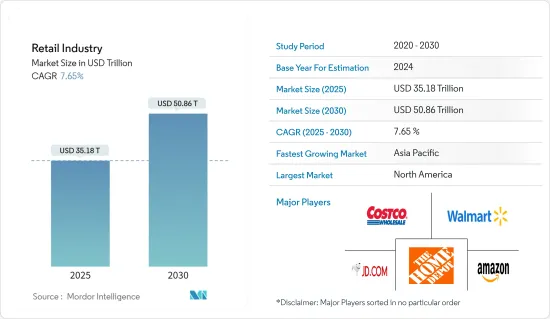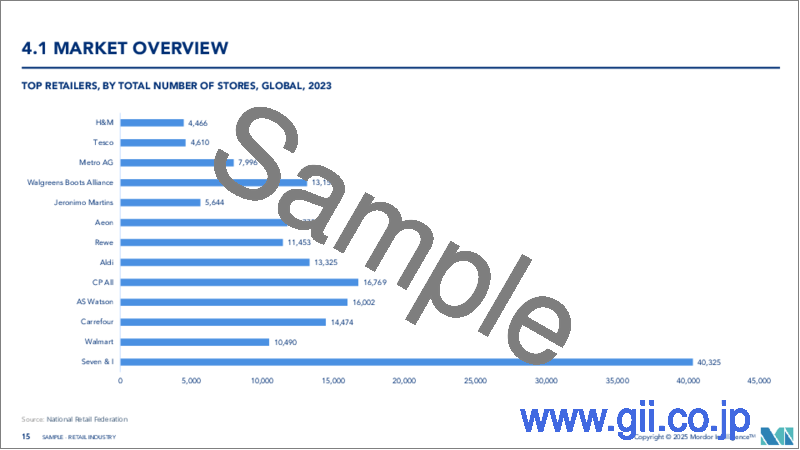|
|
市場調査レポート
商品コード
1639538
リテール業界:市場シェア分析、業界動向・統計、成長予測(2025年~2030年)Retail Industry - Market Share Analysis, Industry Trends & Statistics, Growth Forecasts (2025 - 2030) |
||||||
カスタマイズ可能
適宜更新あり
|
|||||||
| リテール業界:市場シェア分析、業界動向・統計、成長予測(2025年~2030年) |
|
出版日: 2025年01月05日
発行: Mordor Intelligence
ページ情報: 英文 120 Pages
納期: 2~3営業日
|
- 全表示
- 概要
- 目次
リテール業界は、2025年の35兆1,800億米ドルから2030年には50兆8,600億米ドルへと、予測期間中(2025~2030年)のCAGR7.65%で成長すると予測されています。

リテールは、大型小売店から従来型の実店舗、そしてその中間に位置するものまで、多くの企業を含む広範かつダイナミックなセクターです。リテール業界は、消費者の嗜好の変化、技術的向上、市場動向の変化により、常に進化を続けており、大きな転換期を迎えています。eコマースは、デジタル技術の普及、モバイルコマース、買い物行動の変化に後押しされ、圧倒的な力を持つようになった。小売業者は、データ分析、人工知能、パーソナライズされたマーケティング戦略をますます活用し、顧客体験を向上させ、売上を伸ばしています。
さらに、COVID-19の大流行により、小売業はマルチチャネルの小売やオンライン購買への移行を加速させ、顧客の嗜好やニーズの変化に対応した革新と調整を余儀なくされています。持続可能性と社会的責任もまた、小売企業にとって重要な検討事項となっており、消費者は倫理的に調達された製品や環境に配慮した慣行を求めるようになっています。小売企業は、効率性の向上、コスト削減、迅速な配送に対する消費者のニーズの高まりに対応するため、サプライチェーン・オペレーションを改善しています。これには、高度な在庫管理システム、ラストマイル配送ソリューション、倉庫の自動化などの導入が含まれます。全体として、世界のリテール業界は、消費者動向や市場力学が進化する中で、成長とイノベーションの機会を得ながら、依然として高い競争力とダイナミックさを維持しています。
リテール市場の動向
eコマースはリテール業界で最も急成長しているセグメント
eコマースはリテール業界を変革する力として台頭し、企業が消費者と関わり、取引を行う方法に革命をもたらしています。その役割と重要性は否定できず、小売業者に多くのメリットと機会を提供しています。第一に、eコマースは小売業者に世界なリーチを提供し、潜在的な顧客を持つ広大なオンラインマーケットプレースへのアクセスを可能にします。このリーチの拡大は、販売機会を増やすだけでなく、小売業者が顧客ベースを多様化し、ローカル市場への依存を減らすことを可能にします。さらに、eコマースは小売業者と消費者の双方にとって利便性を高める。小売業者は、従来の店舗営業時間に縛られることなく、24時間365日ビジネスを展開することができ、消費者は、自宅や外出先から、いつでもどこでも買い物をすることができます。
eコマースは、家賃、光熱費、人件費など、実店舗の維持に伴う諸経費を削減することで、コスト効率を高める。さらに、eコマースによって、小売業者はデータ分析と顧客インサイトを活用し、パーソナライズされたショッピング体験を提供し、より効果的なマーケティング活動を行い、在庫管理を最適化することができます。顧客の行動や嗜好を分析することで、小売業者は、ターゲットとする顧客のニーズや要望をよりよく満たすために、商品の推奨、プロモーション、広告を調整することができます。全体として、eコマースはリテール業界の成長促進、市場リーチの拡大、顧客体験の向上、業務効率の改善において重要な役割を果たしています。
アジア太平洋地域はリテール業界において最も速い成長率を示すと予測される
アジア太平洋地域は多様性に富み、ダイナミックで、急速に進化しています。この地域には、中国、日本、インド、韓国、オーストラリアなど、世界最大かつ最も急成長しているリテール市場があります。この地域のリテール市場は、中産階級の増加、都市化、消費支出の増加によって活性化しています。アジア太平洋地域では、スマートフォンの普及、インターネット接続の向上、テクノロジーに精通した若年層の増加などを背景に、eコマースが爆発的な成長を遂げています。アリババ(中国)、JD.com(中国)、フリップカート(インド)、Shopee(東南アジア)などのプラットフォームが牽引し、中国、インド、東南アジア諸国などが主要なeコマース市場として台頭しています。
アジア太平洋地域の小売企業は、オンラインとオフラインのチャネルにまたがるシームレスなショッピング体験を提供するため、オムニチャネル戦略を採用する傾向を強めています。この統合により、リテール企業は、ショッピング・ジャーニーに利便性、パーソナライゼーション、柔軟性を求める消費者の進化するニーズに応えることができます。コンビニエンスストア、ミニマート、オンライン食料品宅配サービスなどのコンビニエンスストア業態は、アジア太平洋地域で人気を集めています。アジア太平洋はデジタル決済導入の最前線にあり、アリペイ(中国)、WeChat Pay(中国)、Paytm(インド)、GrabPay(東南アジア)などのモバイル決済プラットフォームが広く受け入れられています。デジタル決済はeコマースの成長を促進し、同地域における金融包摂を可能にしています。
リテール業界の概要
リテール業界は競争が激しく、さまざまな地域プレーヤーが市場に進出しています。同業界で競争優位に立つため、競合各社はAIやARといった最先端技術の活用や協業への取り組みを強化しています。市場の主要企業には、Walmart Inc.、Amazon Inc.、Costco Wholesale Corporation、The Home Depot Inc.、JD.comなどがあります。
その他の特典:
- エクセル形式の市場予測(ME)シート
- 3ヶ月間のアナリストサポート
目次
第1章 イントロダクション
- 調査の前提条件と市場定義
- 調査範囲
第2章 調査手法
第3章 エグゼクティブサマリー
第4章 市場力学と洞察
- 市場概要
- 市場促進要因
- 都市部の急速な拡大
- eコマースとオムニチャネル・リテイリングの台頭
- 市場抑制要因
- サプライチェーンの複雑さ
- 市場機会
- 革新的な小売サービスへの注目の高まり
- 顧客エンゲージメントのためのデータ分析の活用
- バリューチェーン分析
- 業界の魅力ポーターのファイブフォース分析
- 新規参入業者の脅威
- 買い手の交渉力
- 供給企業の交渉力
- 代替品の脅威
- 競争企業間の敵対関係
- 業界の技術的進歩に関する洞察
- COVID-19の市場への影響
第5章 市場セグメンテーション
- 製品タイプ別
- 飲食品、食料品
- パーソナルケア、ハウスホールドケア
- アパレル、履物、アクセサリー
- 家具・インテリア
- 玩具、ホビー、家電製品
- 医薬品
- 流通チャネル別
- スーパーマーケット/ハイパーマーケット
- 専門店
- オンライン
- その他の流通チャネル
- 地域別
- 北米
- 米国
- カナダ
- その他北米
- 欧州
- 英国
- ドイツ
- フランス
- ロシア
- イタリア
- スペイン
- その他欧州
- アジア太平洋
- インド
- 中国
- 日本
- オーストラリア
- その他アジア太平洋地域
- 南米
- ブラジル
- アルゼンチン
- その他南米
- 中東・アフリカ
- アラブ首長国連邦
- 南アフリカ
- その他中東とアフリカ
- 北米
第6章 競合情勢
- 市場集中の概要
- 企業プロファイル
- Walmart Inc.
- Amazon Inc.
- Costco Wholesale Corporation
- The Home Depot Inc.
- JD.com Inc.
- The Kroger Co.
- Walgreens Boots Alliance Inc.
- Alibaba Group Holding Limited
- Target Corporation
- Lowe's Companies Inc.
第7章 今後の市場動向
第8章 免責事項および出版社について
The Retail Industry is expected to grow from USD 35.18 trillion in 2025 to USD 50.86 trillion by 2030, at a CAGR of 7.65% during the forecast period (2025-2030).

Retail is a broad and dynamic sector that includes many enterprises, from big-box retailers to conventional brick-and-mortar establishments and everything in between. The retail industry is undergoing a tremendous transition because of changing consumer tastes, technological improvements, and market trends shaping an ever-evolving landscape. E-commerce has emerged as a dominant force, fueled by the widespread adoption of digital technologies, mobile commerce, and changing shopping behaviors. Retailers increasingly leverage data analytics, artificial intelligence, and personalized marketing strategies to enhance customer experiences and drive sales.
Furthermore, the COVID-19 pandemic has expedited the transition toward multichannel retailing and online buying, forcing merchants to innovate and adjust in response to shifting customer preferences and needs. Sustainability and social responsibility have also become key considerations for retailers, with consumers increasingly seeking ethically sourced products and environmentally friendly practices. Retailers are improving their supply chain operations to improve efficiency, reduce costs, and meet increasing consumer demands for faster delivery. This includes implementing advanced inventory management systems, last-mile delivery solutions, and warehouse automation. Overall, the global retail industry remains highly competitive and dynamic, with opportunities for growth and innovation amidst evolving consumer trends and market dynamics.
Retail Market Trends
E-commerce is the Fastest-growing Segment in the Retail Industry
E-commerce has emerged as a transformative force within the retail industry, revolutionizing how businesses engage with consumers and conduct transactions. Its role and importance are undeniable, offering retailers many benefits and opportunities. Firstly, e-commerce provides retailers with a global reach and enables access to a vast online marketplace of potential customers. This expanded reach not only increases sales opportunities but also allows retailers to diversify their customer base and reduce dependency on local markets. Additionally, e-commerce enhances convenience for both retailers and consumers. Retailers can operate their businesses 24/7 without the constraints of traditional store hours, while consumers can shop anytime and anywhere, from the comfort of their homes or on the go.
E-commerce offers cost efficiencies by reducing overhead costs associated with maintaining physical storefronts, such as rent, utilities, and staffing expenses. Moreover, e-commerce enables retailers to leverage data analytics and customer insights to give personalized shopping experience, target marketing efforts more effectively, and optimize inventory management. By analyzing customer behavior and preferences, retailers can tailor product recommendations, promotions, and advertising to better meet the needs and desires of their target audience. Overall, e-commerce plays a crucial role in driving growth, expanding market reach, enhancing customer experiences, and improving operational efficiency within the retail industry.
Asia-Pacific is Anticipated to Witness the Fastest Growth Rate in the Retail Industry
Asia-Pacific is diverse, dynamic, and rapidly evolving. The region is home to some of the world's largest and fastest-growing retail markets, including China, Japan, India, South Korea, and Australia. The region's retail market is fueled by a growing middle class, urbanization, and increasing consumer spending. E-commerce has experienced explosive growth in Asia-Pacific, driven by the widespread adoption of smartphones, improved internet connectivity, and a young, tech-savvy population. Countries like China, India, and Southeast Asian nations have emerged as major e-commerce markets, with platforms like Alibaba (China), JD.com (China), Flipkart (India), and Shopee (Southeast Asia) leading the way.
Retailers in Asia-Pacific are increasingly adopting omnichannel strategies to provide seamless shopping experiences across online and offline channels. This integration allows retailers to meet the evolving needs of consumers who expect convenience, personalization, and flexibility in their shopping journeys. Convenience retail formats such as convenience stores, mini-marts, and online grocery delivery services are gaining popularity across the region. Asia-Pacific is at the forefront of digital payment adoption, with mobile payment platforms like Alipay (China), WeChat Pay (China), Paytm (India), and GrabPay (Southeast Asia) gaining widespread acceptance. Digital payments are driving the growth of e-commerce and enabling financial inclusion in the region.
Retail Industry Overview
The retail industry is highly competitive, with various local players operating in the market. To gain a competitive advantage in the industry, competitors are increasing their efforts to collaborate and utilize cutting-edge technology, such as AI and AR. Some of the key players in the market include Walmart Inc., Amazon Inc., Costco Wholesale Corporation, The Home Depot Inc., and JD.com.
Additional Benefits:
- The market estimate (ME) sheet in Excel format
- 3 months of analyst support
TABLE OF CONTENTS
1 INTRODUCTION
- 1.1 Study Assumptions and Market Definition
- 1.2 Scope of the Study
2 RESEARCH METHODOLOGY
3 EXECUTIVE SUMMARY
4 MARKET DYNAMICS AND INSIGHTS
- 4.1 Market Overview
- 4.2 Market Drivers
- 4.2.1 Rapid Expansion of Urban Areas
- 4.2.2 Rise of E-commerce and Omnichannel Retailing
- 4.3 Market Restraints
- 4.3.1 Supply Chain Complexity
- 4.4 Market Opportunities
- 4.4.1 Increasing Focus on Innovative Retail Services
- 4.4.2 Harnessing Data Analytics for Customer Engagement
- 4.5 Value Chain Analysis
- 4.6 Industry Attractiveness: Porter's Five Forces Analysis
- 4.6.1 Threat of New Entrants
- 4.6.2 Bargaining Power of Buyers
- 4.6.3 Bargaining Power of Suppliers
- 4.6.4 Threat of Substitutes
- 4.6.5 Intensity of Competitive Rivalry
- 4.7 Insights into Technological Advancements in the Industry
- 4.8 Impact of COVID-19 on the Market
5 MARKET SEGMENTATION
- 5.1 By Product Type
- 5.1.1 Food, Beverage, and Grocery
- 5.1.2 Personal and Household Care
- 5.1.3 Apparel, Footwear, and Accessories
- 5.1.4 Furniture and Home Decor
- 5.1.5 Toys, Hobby, and Household Appliances
- 5.1.6 Pharmaceuticals
- 5.2 By Distribution Channel
- 5.2.1 Supermarkets/Hypermarkets
- 5.2.2 Specialty Stores
- 5.2.3 Online
- 5.2.4 Other Distribution Channels
- 5.3 By Geography
- 5.3.1 North America
- 5.3.1.1 United States
- 5.3.1.2 Canada
- 5.3.1.3 Rest of North America
- 5.3.2 Europe
- 5.3.2.1 United Kingdom
- 5.3.2.2 Germany
- 5.3.2.3 France
- 5.3.2.4 Russia
- 5.3.2.5 Italy
- 5.3.2.6 Spain
- 5.3.2.7 Rest of Europe
- 5.3.3 Asia-Pacific
- 5.3.3.1 India
- 5.3.3.2 China
- 5.3.3.3 Japan
- 5.3.3.4 Australia
- 5.3.3.5 Rest of Asia-Pacific
- 5.3.4 South America
- 5.3.4.1 Brazil
- 5.3.4.2 Argentina
- 5.3.4.3 Rest of South America
- 5.3.5 Middle East and Africa
- 5.3.5.1 United Arab Emirates
- 5.3.5.2 South Africa
- 5.3.5.3 Rest of Middle East and Africa
- 5.3.1 North America
6 COMPETITIVE LANDSCAPE
- 6.1 Market Concentration Overview
- 6.2 Company Profiles
- 6.2.1 Walmart Inc.
- 6.2.2 Amazon Inc.
- 6.2.3 Costco Wholesale Corporation
- 6.2.4 The Home Depot Inc.
- 6.2.5 JD.com Inc.
- 6.2.6 The Kroger Co.
- 6.2.7 Walgreens Boots Alliance Inc.
- 6.2.8 Alibaba Group Holding Limited
- 6.2.9 Target Corporation
- 6.2.10 Lowe's Companies Inc.*






